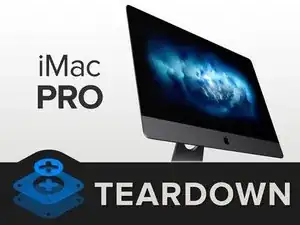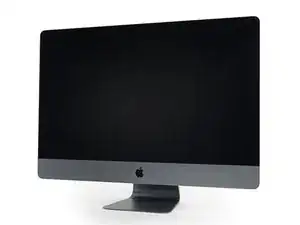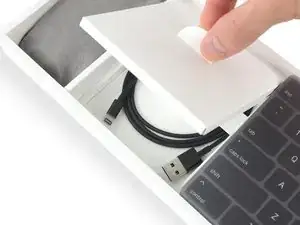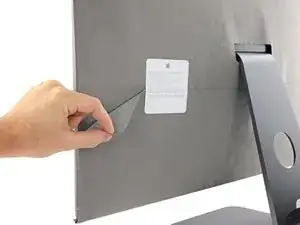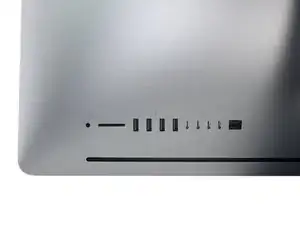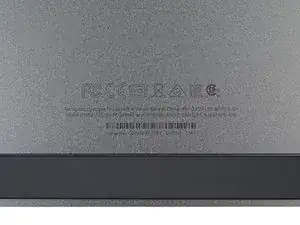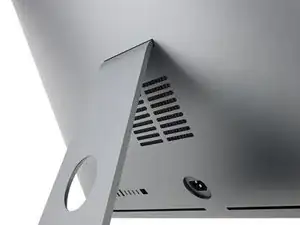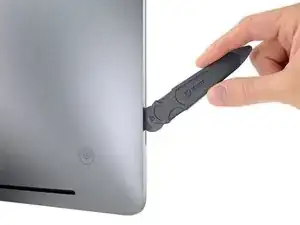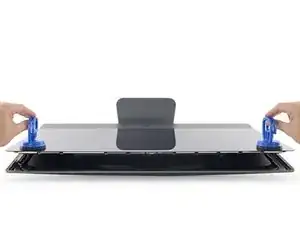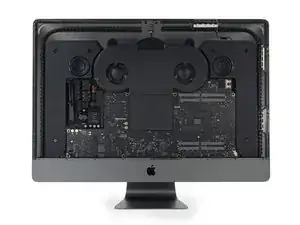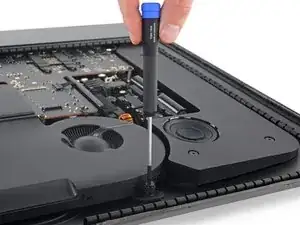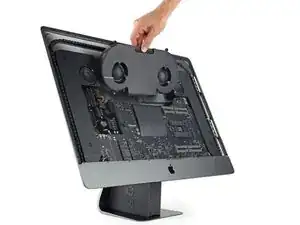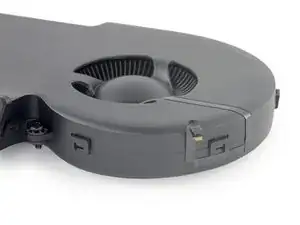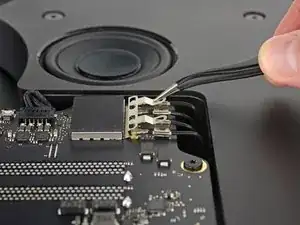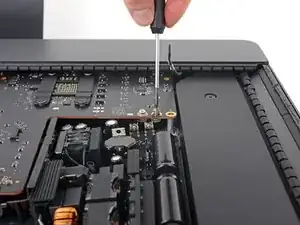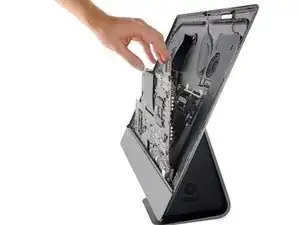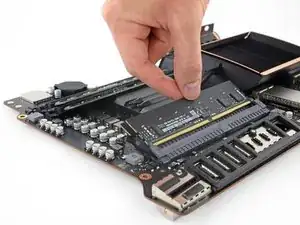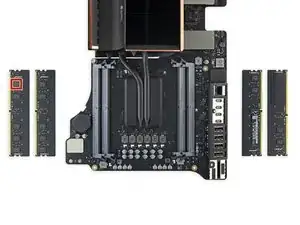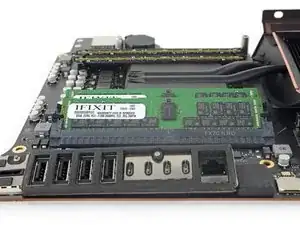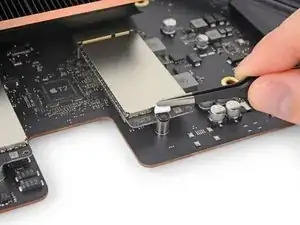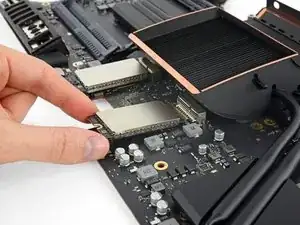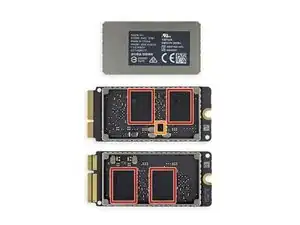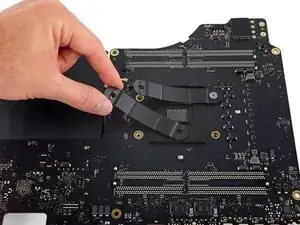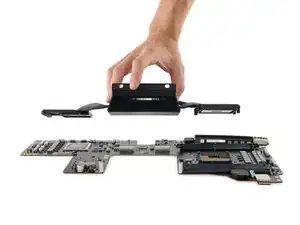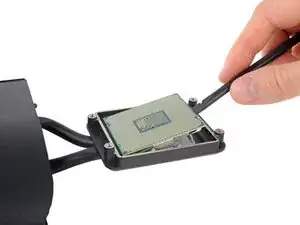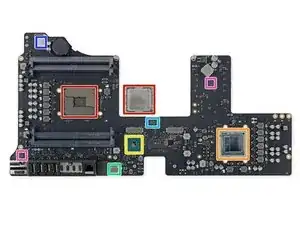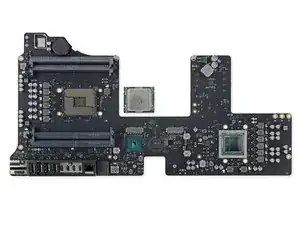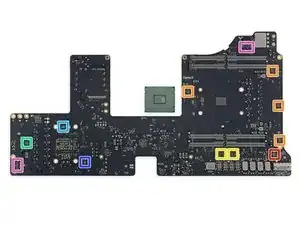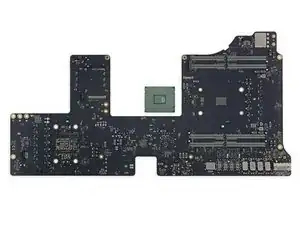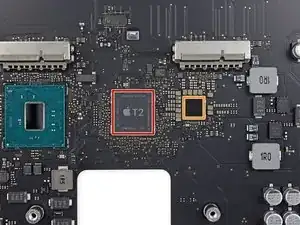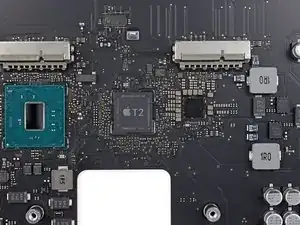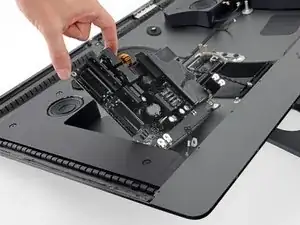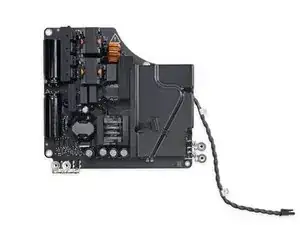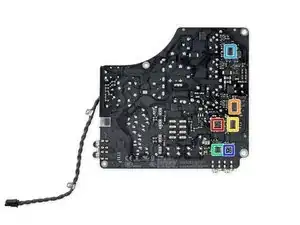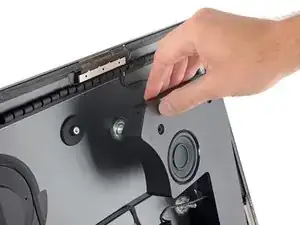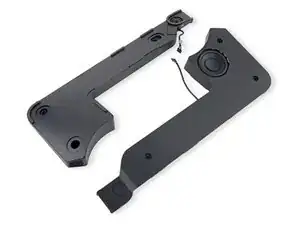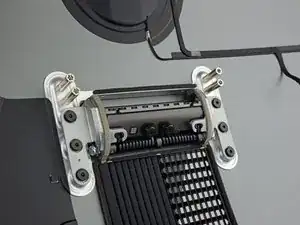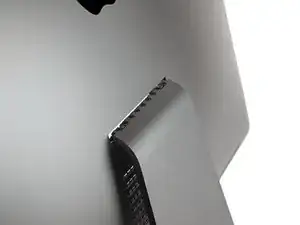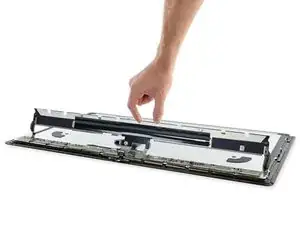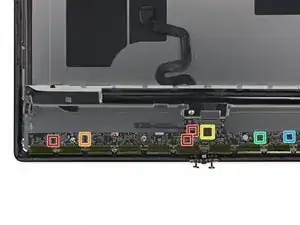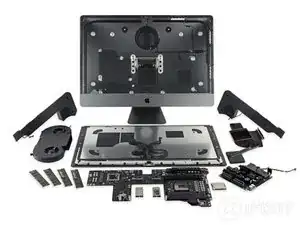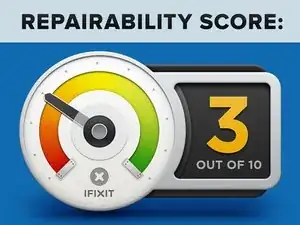Einleitung
Wir haben 4.999 US-Dollar gezahlt, um die heiße neue Magic Mouse und das Magic Keyboard in Space Gray in die Finger zu bekommen – und Apple war so großzügig, einen brandneuen iMac Pro ohne Aufpreis dazuzugeben!
Nehmen wir es also auseinander und sehen, was es zum Ticken bringt.
Folge uns auf Facebook, Instagram und [https:/ /twitter.com/ifixit|Twitter|new_window=true] für die neuesten Teardown-News.
Werkzeuge
-
-
Unser Teardown iMac Pro verfügt über diese „Einstiegsniveau“-Spezifikationen:
-
8-Core, 3,2 GHz Intel Xeon W Prozessor mit Turbo Boost bis zu 4,2 GHz
-
32 GB (4 × 8 GB) 2.666 MHz DDR4 ECC
-
AMD Radeon Pro Vega 56 GPU mit 8 GB HBM2 Speicher
-
27-Zoll-Display mit einer Auflösung von 5120 × 2880 und Unterstützung für eine Milliarde Farben (P3-Farbraum)
-
1 TB SSD
-
High-End-Konfigurationen mit bis zu 18 Prozessorkernen sind verfügbar – wenn du also 13.000 $ oder mehr ausgeben möchtest.
-
-
-
Wir können unsere Aufregung kaum zurückhalten, als wir das großartige Zubehör in Space Grey auspacken – Magic Mouse, Magic Keyboard und *keuch*
-
… ein schwarzes Lightning-zu-USB-Kabel.
-
Wir werden zurück sein, um den Teardown fortzusetzen, nachdem wir uns von dem Schock erholt und aus dem Fenster nach Anzeichen von geflügelten Huftieren geschaut haben.
-
Seltsamerweise gibt es immer noch absolut keine Vorkehrungen – Dongle oder andere – für die Verwendung der Lightning EarPods, die du mit deinem iPhone 7, 8 oder X auf deine iMac Pro erhalten. Erscheint es seltsam, dass diese inkompatiblen Produkte ausgerechnet von Apple stammen?
-
Lass uns die schicke Stoffverpackung des iMac Pro abziehen und die Anschlusssituation überprüfen ... nur um sicherzugehen.
-
-
-
Hier ist die Konnektivitäts-Liste:
-
3,5 mm Kopfhörerbuchse
-
SDXC Kartensteckplatz
-
Vier USB 3 Ports
-
Vier Thunderbolt 3 (USB-C) Ports
-
10 Gb Ethernet Port
-
Falls du es dich gefragt hast, das hier ist die Apple-Modellnummer A1862.
-
Wir haben versucht, RAM in diese Steckplätze auf der Rückseite zu stecken. Es hat nicht funktioniert.
-
-
-
Wir wetten, dass der Öffnungsvorgang der gleiche sein wird wie beim iMac 5K – das heißt, wenn du einen Pizzaschneider verwenden kannst, kannst du einen iMac Pro öffnen.
-
Mit all dem Glas aus dem Weg haben wir eine perfekte Sicht auf das makellose Innere des iMac Pro. Sag mal, wäre das nicht ein schönes Wallpaper für jemanden?
-
-
-
Die erste Komponente ist der riesige Dual-Lüfter-Kühler.
-
Es sieht so aus, als hätte Apple die Desktop-Festplatte in voller Größe des 5K geopfert (nicht, dass du das in einem Profi-Computer haben wollen würdest), um hier etwas Platz zu schaffen.
-
Ebenfalls den Kühlgöttern geopfert: die externe RAM-Zugriffsklappe. Sehr traurig.
-
Dafür bekommen wir einen großen hinteren Luftauslass und eine um 80 % gesteigerte Kühlleistung.
-
-
-
AirPort-Kartenfunktionen sind auf der Hauptplatine verbaut – aus unbekannten Gründen hat Apple die Modularität des 5K-Modells aufgegeben. Aber wir haben diesen ungewöhnlichen neuen Halteclip für die Koaxialkabel erkannt.
-
Das Netzteil wird nicht über einen, nicht zwei, sondern über vier glänzende Klemmen, die mit Torx-Schrauben gesichert sind, mit der Hauptplatine verbunden.
-
Es macht auch den Zugriff auf Komponenten auf der Hauptplatine (abgesehen vom RAM natürlich) viel, viel einfacher. Wenn das Netzteil wieder in der hinteren Schale steckt, können wir die Platine sofort entfernen. Lass uns das tun!
-
-
-
Wenn die Platine entfernt ist, ist die erste Aufgabe, den Arbeitsspeicher zu inspizieren.
-
Man kann es nicht anders sagen: Der Weg hierher war ein großes Unterfangen im Vergleich zu der kinderleichten RAM-Zugriffsklappe auf der Rückseite aller vorherigen 27-Zoll-iMacs.
-
Trotzdem haben wir eine gute Nachricht: Dies sind standardmäßige 288-Pin-DDR4-ECC-RAM-Sticks mit Standard-Chips an Bord:
-
SKhynix H5AN8G8NAFR-VKC 2.666 MHz DDR4
-
Wir verlieren keine Zeit und testen ein kleines Upgrade: Wie klingen vier 32-GB-Module auf "maximum" insgesamt 128 GB?
-
Nachdem wir alles schnell wieder zusammengebaut haben, freuen wir uns, berichten zu können, dass das Ergebnis episch ist. Wenn du es zu Hause ausprobieren möchtest, hol dir ein Memory Maxxer RAM-Upgrade-Kit.
-
-
-
Zurück zum Zerlegen desTeils: Als nächstes kommen diese Doppel-SSDs.
-
Unter ein paar Aufklebern finden wir einige Torx-Schrauben. Los geht's!
-
Jedes Blade trägt die Bezeichnung Apple EMC 3197, Modell 656-0061A.
-
Wenn wir die Abschirmungen abnehmen, stoßen wir auf einige Chips:
-
SanDisk SDRQF8DC8-128G (vier pro Karte, zwei oben und zwei unten, für insgesamt 512 GB × 2 = 1024 GB)
-
Apple 338S00285 Power-Management-IC (wahrscheinlich)
-
Im Gegensatz zu einer Standard-SSD, die die Controller-Logik an Bord hat, haben diese Raw-Flash-Module nur einen Schnittstellenpuffer – der PCIe/NVMe-Controller liegt woanders. Mehr dazu gleich.
-
-
-
Willst du wissen, was sich unter diesem riesigen Kühlkörper verbirgt? Wir auch. Nachdem wir noch ein paar Torx-Schrauben weg gewirbelt und die Befestigungsfedern beiseite geworfen haben, haben wir eine Antwort:
-
Eine GPU, die leider BGA-gelötet ist. Und auf der gegenüberliegenden Seite ein Xeon-Prozessor der Workstation-Klasse – nicht verlötet.
-
Es wäre schön, wenn deine 5.000-Dollar-Workstation von Zeit zu Zeit ein Upgrade erhalten könnte, anstatt einen vollständigen Ersatz ... oder?
-
-
-
Wir haben die Platine geleert, und es ist Zeit für einen Überblick über das Silizium:
-
Intel Xeon W-2140B (Skylake, 14 nm – wahrscheinlich ein untertakteter W-2145, um die Temperaturen unter Kontrolle zu halten), 3,2-GHz-CPU mit Turbo Boost bis zu 4,2 GHz, gepaart mit etwas, das durchaus ein Standard-LGA-2066-Sockel sein könnte
-
AMD S5J68 1747 GPEW0333S3 SS63HBN181747US40104 Radeon Pro Vega 56 GPU mit integriertem 8 GB HBM2-Speicher (im Lieferumfang enthalten)
-
Intel X723D733 E1 05780 (SR3PV?) - wahrscheinlich Plattform-Controller-Hub
-
AQUANTIA AQtionAQC107-B1-C PCIe-zu-Multi-Gigabit-Ethernet-Controller
-
Pericom Semiconductors PI3PCIE3412AZHE PCIE 3.0 Mux/Demux-Schalter
-
Apple/Universal Scientific Industrial (USI) 339S00428 00012021 Wi-Fi/Bluetooth-Modul
-
Genesys Logic GL3227A SD 4.0-Speicherkartencontroller und Texas Instruments LP8565A13 (wahrscheinlich LED-Hintergrundbeleuchtungstreiber)
-
-
-
Rückseite:
-
Cirrus Logic CS42L83 Audio/DAC
-
3x Infineon (ehemals Primarion) PXE1110CDM und PXE1610CDN Mehrphasen-Digitalcontroller
-
2x Intel JHL6540 Thunderbolt 3-Controller
-
International Rectifiers IR35217 Endstufenregler
-
Serieller CMOS-Flash-Speicher Macronix MCIC MX25L4006EZNI
-
NXP PCAL6524 I/O-Expander
-
4x Texas Instruments TAS5764L Audioverstärker
-
-
-
Zu guter Letzt haben wir in der Nähe der SSD-Steckplätze zwei benutzerdefinierte Apple-Chips:
-
Apple T2 339S00467 über SK Hynix H9HKNNNBRUMUVR-NLH LPDDR4 geschichtet
-
Apple 338S00268 – dieser Chip ist ein bisschen mysteriös. In unserer anfänglichen Aufregung dachten wir, es sei der gemunkelte A10 Fusion Coprozessor, der erstmals im iPhone 7 zu sehen war, aber die Gehäusegröße ist zu klein (ungefähr 7,4 mm auf jeder Seite). Beste Vermutung: Dies ist ein Power-Management-IC von Apple/Dialog Semi.
-
Der Nachteil all dieser zusätzlichen Funktionalität und Sicherheit ist ein großes Problem, wenn dein iMac Pro jemals wiederhergestellt werden muss.
-
-
-
Wenn das Logic Board aus dem Weg ist, können wir das 500-Watt-Netzteil herausziehen.
-
Hergestellt von AcBel Polytech Inc., akzeptiert 100-240 Volt Wechselstrom und enthält selbst etwas Silizium:
-
STMicroelectronics STD4N80K5 3 A N-Kanal-MOSFET
-
STMicroelectronics L6599A Hochspannungs-Resonanzcontroller
-
Strommodus-Controller NCP1336B von ON Semiconductor
-
Diodes Incorporated AP4310A dualer operationeller Verstärker mit Spannungsreferenz
-
ON Semiconductor NCP1631 2-Phasen-Leistungsfaktorregler
-
Diodes Incorporated https://www.diodes.com/part/view/AP2125 300 mA LDO-Regler
-
-
-
Die Hülle dieses iMac sieht ein bisschen kahl aus, aber wir sind noch nicht fertig: Die "erweiterten Stereolautsprecher" sind als nächstes dran.
-
Frühe Berichte besagen, dass diese Lautsprecher dem Hype gerecht werden: Sie sind die am besten klingenden Lautsprecher, die du für einen Mac bekommen kannst.
-
… bis du, wie wir vermuten, es mit einem Homepod koppeln kannst - was das gesamte Erlebnis auf die nächste Stufe heben sollte. Wir werden es nicht sicher wissen, bis der Homepod irgendwann im Jahr 2018 endlich in die Regale kommt. (Ist es nur Zufall, dass er ein bisschen wie ein Mac Pro aussieht?)
-
-
-
Wir haben dieses Gehäuse nach Teilen durchforstet, und es ist nicht viel übrig geblieben – außer dem unverschämt beeindruckenden federbelasteten Scharnier-Mechanismus, der das Display trägt.
-
Dies ist wahrscheinlich das einzige Mal, dass Apple dir einen Schraubendreher verkauft und dir sagt, dass du es machen kannst.
-
Wenn du dies liest, besteht natürlich eine gute Chance, dass du bereits vollständig vorbereitetbist.
-
-
-
Zeit, sich dieses Display genauer anzusehen. Es stellt sich heraus, dass es dasselbe Display-Panel verwendet, das wir im iMac 5K gefunden haben: LG Display-Modell LM270QQ1.
-
Wir lösen den langen Abschirmstreifen entlang der Unterseite ab, um die Chips freizulegen:
-
Texas Instruments NH245 8-Bit Bus-Transceiver mit doppelter Versorgung
-
Texas Instruments BUF16821 Programmierbarer Gamma-Spannungsgenerator und Vcom-Kalibrator
-
Parade Technologies DP665 LCD Timing-Controller
-
Texas Instruments TPS54320 Synchroner 3-A-Abwärts-SWIFT™-Wandler
-
Texas Instruments TPS65168 Hochauflösender, vollständig programmierbarer LCD-Vorspannungs-IC für Fernseher.
-
-
-
Das war's, Leute. Zeit, dieses Biest mit etwas frischer Wärmeleitpaste wieder zusammen zubauen und zu sehen, wie es sich als Gaming-Setup schlägt.
-
Nur für den Fall, dass du dich fragst: Ja, es ging wieder gut zusammen. Wir haben bald eine Schritt-für-Schritt-Upgrade-Anleitung für dich!
-
-
-
iMac Pro reparierbarkeits-Score: 3 von 10 (10 ist am einfachsten zu reparieren)
-
Der Arbeitsspeicher und die CPU sind beide modular, was bedeutet, dass Reparaturen und Upgrades problemlos möglich sind – ungeachtet dessen, was Apple dir sagt.
-
Die Dual-SSDs sind modular, aber von Apple maßgeschneidert, was den Austausch erschwert.
-
Das Klebeband zum Öffnen des iMac zu durchschneiden ist nicht allzu schwer (mit den richtigen Werkzeugen), aber es muss dann ersetzt werden, um eine Reparatur abzuschließen.
-
Wichtige austauschbare Komponenten sind hinter der Hauptplatine vergraben und erfordern eine Menge Demontage für den Zugang.
-
Der Wegfall der Zugangsklappe zum externen RAM macht Upgrades im Vergleich zum 27" iMac 5K wesentlich komplizierter.
-
Die GPU ist BGA-gelötet – möglicherweise ein großer Nachteil auf einer „Profi“-Workstation. Es sind keine einfachen Grafik-Upgrades möglich, also wähle deine Konfiguration mit Bedacht aus.
-
101 Kommentare
OOH FIRST COMMENT! either way, Apples getting closer and closer to the point where a mac will literally be one single part that will not be modular in any way. Apple says they save the environment as much as possible while sweeping the fact that they make their machines as hard to fix as possible under the carpet.
Aiden -
Wow you got here first!
Apple bounces back and forth between more and less modularity with most new architectures. Claiming that there is some obvious trend here is silly and baseless.
Mark -
This comment aged like fine wine with the launch of the M1-based iMacs.
Liquid cooling? SSD in RAID 0?
It’s one SSD controller on two sticks of dumb NAND, no need for a RAID.
tipoo -
Liquid cooling requires a quite grand radiator/pump ! So NO this wont be possible in this very tightly packed overheated ALL-IN-ONE-MAC(PC)!
What does the SSD shows at “Apple - About This Mac - System Report - Hardware - Storage?
